In just over six weeks, I'll be headed back to South Carolina for a second tour of duty chasing Redfish on the grassy flats in South Carolina's lowcountry. Somehow, I managed to visit the South Carolina coast three times before my most recent visit without prioritizing the chasing of redfish, each time kicking myself after the fact for letting other things get in the way. After finally making my first redfish trip earlier this year, I can safely say my future visits to the lowcountry will always be marked by at least one day on a skiff. Not only was my first outing for Redfish a successful one, but I was fortunate enough to have timed my trip during Cobia season as well.

As I planned for the trip, I did by best to evaluate what my chances of success would be on my own, exploring. When possible, this is how I prefer to experience new locations, but it isn't always the best way to go about things.
There are places in the lowcountry where you can fish for redfish simply by walking onto a flat from a relatively easy access point. You have to be in the right phase of the moon for the tides to bring the fish to these easily accessible short-grass flats, you have to be there at the right time of day, and you have to -- of course -- know where these flats are. I didn't: Strike One.
Another, less traditional option is fishing saltwater impoundments which are found scattered on various islands along the coast. These low-lying areas of trapped sea water are filled up during the highest tides of the month, trapping water and fish when the tide quickly receeds. As luck would have it, it just so happened that the island that we were staying on (Fripp Island) had a few of these impoundments. As luck would also have it, not only could one find redfish in these impoundments, but alligators. To fish these areas safely you need to be sure to A) stay out of the water, B) keep a watchful eye out for alligators while doing your best to present a fly to an easily spooked red and C) make sure, should you hook a fish, to not let your excitement at hooking and playing the fish entice you to step into the water or stop watching for alligators (in other words, forget A and B). Having recently read a story about an elderly man who's arm was ripped clean off by a 350 pound alligator on that very same island just a couple years before: Strike Two.
The remaining options required a skiff / flats boat and knowledge of where the fish are to be found in the vast amount of identical-looking water along the lowcountry coast. As I possessed neither of these items: Strike Three.
Enter Tuck Scott. Tuck is a 25-year veteran of the South Carolina lowcountry, having grown up fishing the area rivers, bays, and flats with his grandfather. Now head guide for Beaufort, SC's Bay Street Outfitters, Tuck has the reputation of being the go-to redfish guide in the area. Naturally, given three days in the area, I booked a charter with Tuck for day one. Not only did this get the fishing bug out of the way early, it allowed for the option of an impromptu second or third fishing day. Solid thinking all around.
As it turned out, booking on day one was a blessing. Wind forced us to back off fishing plans two days in a row. Come 7:45am of the third day, winds over the flats near Fripp Island weren't looking any better, but reports of a surprisingly starkly contrasting situation up the coast near Beaufort offered us a chance to take a shot at a day of fishing.

Persistence paid off. After hitting the water shortly before 9 and failing to find schools of fish in the first two locations Tuck navigated the boat to, we ran into a fairly healthy school about an hour into the charter. After finding my legs on the deck of the boat, and following a myriad of Tuck's advice, I hooked into a healthy redfish which didn't disappoint in its efforts to remove the hook lodged squarely in the corner of its jaw. After playing the fish for a few minutes, I intelligently inquired of my guide "how often do they throw the hook?" The expression on Tuck's, which read "seriously, did you really?" said it all, and within about 6 seconds the line shook and went slack. You know the rest.
Several more redfish were hooked as the day wore on, the remainder of which came to hand, each one adding to the soreness of my right arm. Fishing for these stunning fish isn't easy, but it isn't hard either. Anyone able to chuck a cast over 40 feet with reasonable accuracy has a good shot at these fish. If you can chuck one 60-80 feet, your odds improve dramatically. Either way, if you're a competent fisherman, the odds of getting into fish are good.
We ended the day by spending a couple hours seeking out Cobia. Fishing for Cobia is, to put it mildly, like no other fishing I've ever done. How often do you sight-fish to a solitary fish in clear, glass-still, open water with a fly as big as your hand and as gaudy as a Mardi Gras costume? Not only can you see the fish, it can see you. And it could care less. Presenting your fly to a cobia and getting a follow is relatively easy, getting a take it is another matter.

In two hours, we found and cast to six different cobia. Mind you, finding a single fish can easily take 30 minutes of slowly cruising the river, eyes peeled for disturbed or "pushed" water. It's a patient man's game. Each of the first five cobia followed my stripped offerings for a few moments, only to turn away in disinterest just when I expected them to escalate their pursuit. Cobia #6 was different. After dropping the fly a few feet off its nose, the fish eagerly followed the fly for 20 yards. The cobia's pursuit continued until I had stripped all of the my fly line in, leaving only the leader extending from the tip of my rod and no way to keep the fish in pursuit other than moving the rod itself, dragging the fly through the water. Within feet of the boat and with the fly about to break the surface of the water, the fish engulfed the fly and turned hard to take it below. Surprising myself, I reacted appropriately to the take, pausing for a solid second or two before attempting to set the hook. Nonetheless, a fish who pursued and aggressively took the fly and whose turn on the fly, combined with my rod position, made it all but impossible to avoid a hook set, managed to gracefully shake its head once and spit out the fly. Tuck's bewilderment seemed to exceed my own, and for some reason that was consolation enough for losing what seemed a sure thing.
Unfortunately, when I return to the lowcountry next month, there will be no cobia to pursue. The redfishing, however, should be even better.





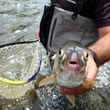
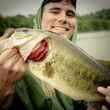










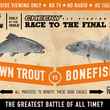



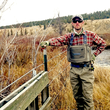




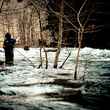
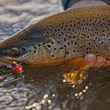


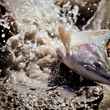
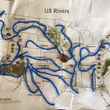
Comments